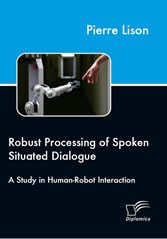Suchen und Finden
Robust Processing of Spoken Situated Dialogue
1
Abstract
4
Zusammenfassung
4
Résumé
4
Acknowledgements
8
Introduction
15
Processing spoken dialogue
16
The issues
16
Key ideas of our approach
19
Discussion and relation to previous work
20
Human-robot interaction
23
A short historical background
23
Scientific relevance of HRI
25
Dimensions of HRI
26
Cognitive systems for HRI
27
Considered scenarios
28
Playmate scenario
28
Explorer scenario
29
Outline
29
Contributions
31
I Background
33
Situated spoken dialogue
35
Linguistic analysis of spoken dialogue
35
Example from the Apollo corpus
35
Theoretical analysis
39
Language, context and human cognition
42
Phylogenetic and ontogenetic origins
42
Situated human language processing
43
Five working hypotheses
44
Summary of the chapter
45
Theoretical foundations
47
Combinatory Categorial Grammar
47
Lexicon
48
Combinatory rules
49
Derivations
49
Hybrid Logic Dependency Semantics
49
Hybrid logic
50
Encoding linguistic meaning
53
Syntax-semantics interface
54
Segmented Discourse Representation Theory
56
Dynamic semantics
56
Rhetorical relations
58
The SDRT approach in brief
59
Event structure
60
Summary of the chapter
60
Software architecture
63
Global architecture
64
Cognitive Systems Architecture Schema
64
CAST: an implementation toolkit for CAS
65
The communication subarchitecture
68
Representations
68
Processes
74
Summary of the chapter
80
II Approach
83
Situated Speech Recognition
85
Introduction to the issue
85
Psycholinguistic motivation
86
Salience modeling
86
Visual salience
87
Linguistic salience
87
Cross-modal salience model
88
Lexical activation
89
Language modeling
90
Corpus generation
90
Salience-driven, class-based language models
91
Evaluation
92
Evaluation procedure
92
Results
92
Analysis
93
Summary of the chapter
94
Robust Parsing of Spoken Dialogue
95
Grammar relaxation
97
New type-shifting rules
97
Paradigmatic heap rules
100
Discourse-level composition rules
101
ASR error correction rules
101
Control of grammar relaxation
102
Discriminative models for parse selection
102
Definition of the task
102
A distribution-free approach
103
Learning
105
Training data
105
Averaged perceptron
106
Decoding
107
Features
109
Semantic features
109
Syntactic features
110
Contextual features
111
Speech recognition features
112
Additional extensions
113
Incremental parse selection
113
Max-margin classifier (SVM)
116
Summary of the chapter
117
III Evaluation & Conclusion
119
Evaluation
121
Testing data
121
Evaluation procedure
122
Types of quantitative results
122
Quantitative results
124
Comparison with baseline
125
Discussion of results
128
Conclusion
131
Suggestions for further research
132
IV Appendices
137
Packing algorithm
139
Example
139
Data structures
142
Pseudo-code
144
Detailed results for parse selection
147
Tables
147
Figures
151
Global results with all NBest hypotheses
151
Detailed results for exact-match
153
Detailed results for partial-match
155
Domain-specific grammar for corpus generation
157
Definitions
157
Grammar specification
158
References
177
Index
195
Alle Preise verstehen sich inklusive der gesetzlichen MwSt.





















